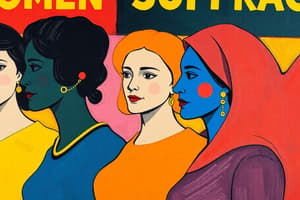Podcast
Questions and Answers
What was a primary obstacle suffragists faced in gaining support from Congress in the late 19th century?
What was a primary obstacle suffragists faced in gaining support from Congress in the late 19th century?
- The lack of diverse leadership within the suffrage movement, limiting its appeal to a broader electorate.
- Congressional apprehension that granting women the right to vote would lead to undesired political outcomes. (correct)
- Disagreement among suffragists on whether to prioritize state-level campaigns or a constitutional amendment.
- The government's preoccupation with economic reforms and industrial growth, overshadowing social issues.
How did the division within the suffrage movement impact their overall strategy and progress?
How did the division within the suffrage movement impact their overall strategy and progress?
- It led to experimentation with a variety of tactics, increasing pressure on lawmakers and public awareness.
- It streamlined their messaging, resulting in a more cohesive and persuasive argument for women's enfranchisement.
- It weakened their collective bargaining power, allowing opponents to exploit their differences and delay legislative action. (correct)
- It fostered a more inclusive environment, encouraging women from diverse backgrounds to join the cause.
In what way did the suffragists' tactics evolve over time, and what was the rationale behind these changes?
In what way did the suffragists' tactics evolve over time, and what was the rationale behind these changes?
- They shifted from peaceful demonstrations to advocating for armed resistance, believing it was the only way to gain the government's attention.
- They moved away from political activism to focus on grassroots community organizing, aiming to build a broad base of support.
- They abandoned their pursuit of a constitutional amendment in favor of focusing solely on state-level campaigns for suffrage.
- They transitioned from polite lobbying to more confrontational and militant actions, to attract attention and disrupt the status quo. (correct)
What was the primary significance of the Seneca Falls Convention in relation to women's suffrage?
What was the primary significance of the Seneca Falls Convention in relation to women's suffrage?
What critical factor distinguished the political climate in 1919, allowing the suffrage amendment to finally pass through Congress, after decades of failed attempts?
What critical factor distinguished the political climate in 1919, allowing the suffrage amendment to finally pass through Congress, after decades of failed attempts?
What was the immediate impact of the Nineteenth Amendment's ratification on the American electorate and political landscape?
What was the immediate impact of the Nineteenth Amendment's ratification on the American electorate and political landscape?
Which factor most significantly limited suffrage in the early years of the United States, as described in the content?
Which factor most significantly limited suffrage in the early years of the United States, as described in the content?
What is the most accurate interpretation of the Constitution's stance on suffrage at the time of its adoption in 1789?
What is the most accurate interpretation of the Constitution's stance on suffrage at the time of its adoption in 1789?
What was the primary strategy adopted by women's rights activists after the Seneca Falls Convention to achieve suffrage?
What was the primary strategy adopted by women's rights activists after the Seneca Falls Convention to achieve suffrage?
Based on the context provided, what can be inferred about the term 'suffrage'?
Based on the context provided, what can be inferred about the term 'suffrage'?
Flashcards
Suffrage
Suffrage
The right to vote.
Early Voting Restrictions
Early Voting Restrictions
Originally, only free white men over 21, who were educated and owned property could vote.
U.S. Constitution
U.S. Constitution
The governing law of the United States, established in 1789.
Women's Exclusion
Women's Exclusion
Signup and view all the flashcards
Seneca Falls Convention
Seneca Falls Convention
Signup and view all the flashcards
Who were Suffragists?
Who were Suffragists?
Signup and view all the flashcards
When was the 19th Amendment ratified?
When was the 19th Amendment ratified?
Signup and view all the flashcards
What did the 19th Amendment do?
What did the 19th Amendment do?
Signup and view all the flashcards
Who was Sojourner Truth?
Who was Sojourner Truth?
Signup and view all the flashcards
Who was Lucretia Mott?
Who was Lucretia Mott?
Signup and view all the flashcards




